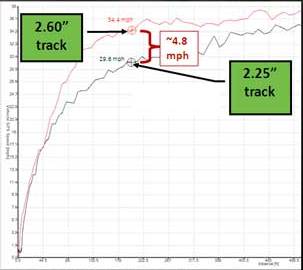In addition to changes mentioned in the previous two posts HERE and HERE, Arctic Cat has updated its 2013 M sleds with several noteworthy improvements.
The biggest news is the 2-in. narrowing of the ski stance to 38-39-in. (compared to the previous 40-41-in. stance) on all but two models (M8 HCR and M1100). I can vouch that this change alone makes a HUGE improvement in the ease of laying the sled down in deep snow.
The portion of each M spindle that the steering arm attaches now has two holes: One in the standard (rearward) position, and one that’s closer to the spindle.
The new “forward” hole delivers a 17.5% tighter turning radius for a given amount of handlebar movement. Consequently, it also requires more steering effort. It’s an easy change to make.
On the 2013 M models with the ProClimb chassis, Arctic Cat has revised the front arm mounting location in the tunnel 3/4-in. lower than on the 2012 models, while mounting the rear arm in the lower hole (which is an existing hole on the ’12 models).
The reason? There are three: Getting the sled to roll up and out of the snow better; improved performance in deep snow; and increasing the track-to-tunnel clearance to accommodate the new 2.6-in. PowerClaw track.
Speaking of which, the new 2.6-in. Powerclaw is among the tallest available OE tracks. Arctic Cat did a lot of testing on this unit prior to giving it the green light. Compared to the previous 2.25-in. track, the 2.6-in. track is 2-3 lbs. heavier, which slightly slower top speeds on flat, hard-pack trails. However, its performance in deep snow is better (see below).
Near its western R&D facility, Arctic Cat ran through a battery of track comparison tests, including a speed/hill test.
The test results proved that the the 2.6 PowerClaw accelerated quicker, with a significant increase in top speed.
Like so many things, there’s a tradeoff. In this case, it’s a 3 mph reduction in top speed on the flats.
Compare the above two images to see a change made to the clutch-side of the side panels of the 2013 M models. It’s a response to some riders experiencing snow ingestion on the left-side panels while side-hilling, due to the panels flexing under the weight and opening up enough to let in snow.
The new fastener on the side panel prevents the flexing/ingestion.
A special note about the HCR models: they come with the front heat exchanger only (rather than the full tunnel exchanger used on the other M models). It’s a system that weighs less both “stock dry weight” as well as “real-world riding weight,” the latter of which can sometimes see upwards of a 40-lb. savings due to less accumulated snow/ice.
Of course, like everything there’s a tradeoff, and in the case of the HCR it’s that ice scratchers are a must-run item in dry/hardpack conditions.
Finally, there’s been some confusion about difference between the “laydown” steering post angle versus the vertical steering, (of which there are essentially two versions). The above slide illustrates the three steering post options for the various mountain machines.
Key to note is that vertical steering is now utelized on most 2013 4-stroke M machines, and that only the 800 engine models have telescoping steering.
Thanks for reading.
